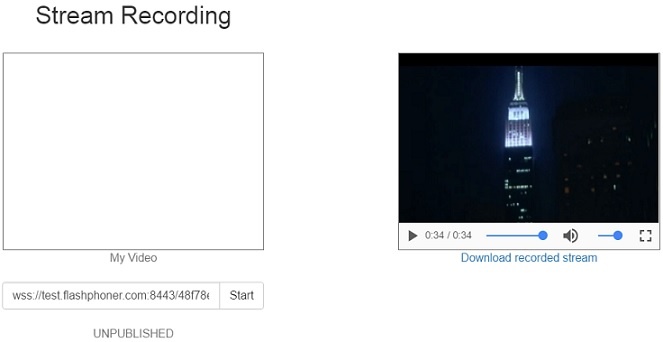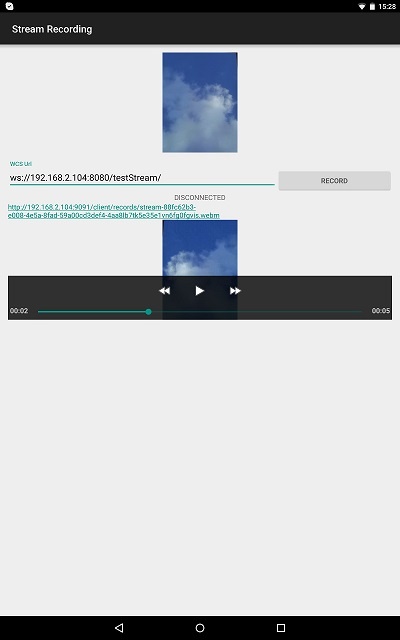...
- download link for the recording of published stream
- media player, which can be used to play the recording
Work with code of the example
To analyze the code, let's take class StreamRecordingActivity.java of of the stream-recording example version with hash 4ed4c6d77, which can be downloaded with corresponding build 1.0.1.338.
1. Initialization of the API. line 72
...
...
Flashphoner.init(
...
)
...
For initialization, object Сontext is passed to the init() method.
2. Connection to server.
Session for connection to server is created when Record button is clicked. line 109
| Code Block | ||||
|---|---|---|---|---|
| ||||
session = Flashphoner.createSessioninit(sessionOptionsthis); |
Session is created with method createSession(), to which object SessionOptions (line 103) with 2. Session creation.
Flashphoner.createSession() code
Object SessionOptions with the following parameters is passed to createSession() method:
- URL of WCS server
- SurfaceViewRenderer, which will be used to display video from the camera
Callback functions for session events are added (line 114)
- onConnected() - will be called when connection is successfully established
- onDisconnection() - will be called when connection is closed
| Code Block | ||||
|---|---|---|---|---|
| ||||
SessionOptions sessionOptions = new SessionOptions(url);
sessionOptions.setLocalRenderer(localRender);
/**
* Session for connection to WCS server is created with method createSession().
*/
session = Flashphoner.createSession(sessionOptions); |
3. Connection to the server.
Session.connect(). code
| Code Block | ||||
|---|---|---|---|---|
| ||||
session.onconnect(new SessionEvent() { Connection()); |
4. Receiving the event confirming successful connection
session.onConnected() code
| Code Block | ||||
|---|---|---|---|---|
| ||||
@Override public void onConnected(final Connection connection) { runOnUiThread(new Runnable() { .....@Override } public void onDisconnectionrun(final Connection connection) { mStartButton.setText(R.string.action_stop); mStartButton.setTag(R.string.action_stop); } }); |
Method Session.connect() is called to establish connection with WCS server. line 224
| Code Block | ||||
|---|---|---|---|---|
| ||||
session.connect(new Connection()); |
3. Video streaming.
...
mStartButton.setEnabled(true);
mStatusView.setText(connection.getStatus());
...
}
});
} |
5. Video stream creation
Session.createStream(). line 141, ActivityCompat.requestPermissions() code
Object StreamOptions (line 135) with is passed to the sreateStream() method
- name of the stream
- true for parameter 'record' - to enable stream recording
| Code Block | ||||
|---|---|---|---|---|
| ||||
StreamOptions streamOptions = new StreamOptions(streamName);
streamOptions.setRecord(true);
/**
* Stream is created with method Session.createStream().
*/
publishStream = session.createStream(streamOptions); |
Callback function for processing stream statuses is added. (line 146)
| Code Block | ||||
|---|---|---|---|---|
| ||||
/** * Callback function for stream status change is added to display the status. */ publishStream.on(new StreamStatusEvent() { @Override public void onStreamStatus(final Stream stream, final StreamStatus streamStatus) { runOnUiThread(new Runnable() { @Override public void run() { if (StreamStatus.PUBLISHING.equals(streamStatus)) { mStatusView.setText("RECORDING"); /** * Filename of the recording is determined. */ recordFilename = stream.getRecordName(); return; } else if (StreamStatus.FAILED.equals(streamStatus)) { Log.e(TAG, "Can not publish stream " + stream.getName() + " " + streamStatus); recordFilename = null; } mStatusView.setText(streamStatus.toString()); } }); } }); |
...
|
6. Video stream publishing when permissions is granted
Stream.publish() is called to publish the stream. line 173 code
| Code Block | ||||
|---|---|---|---|---|
| ||||
case PUBLISH_REQUEST_CODE: {
if (grantResults.length == 0 ||
grantResults[0] != PackageManager.PERMISSION_GRANTED ||
grantResults[1] != PackageManager.PERMISSION_GRANTED) {
mStartButton.setEnabled(false);
session.disconnect();
Log.i(TAG, "Permission has been denied by user");
} else {
/**
* Method Stream.publish() is called to publish stream.
*/
publishStream.publish(); |
4. Filename of the recording. line 158
...
Log.i(TAG, "Permission has been granted by user");
}
} |
7. Receiving the event confirming successful stream publishing
StreamStatusEvent PUBLISHING code
On this event, stream record filemane is defined with Stream.getRecordName() is used to get the filename of the stream recordingmethod.
| Code Block | ||||
|---|---|---|---|---|
| ||||
publishStream.on(new StreamStatusEvent() { @Override public void onStreamStatus(final Stream stream, final StreamStatus streamStatus) { runOnUiThread(new Runnable() { @Override public void run() { if (StreamStatus.PUBLISHING.equals(streamStatus)) { mStatusView.setText("RECORDING"); /** * Filename of the recording is determined. */ recordFilename = stream.getRecordName(); return; } else if (StreamStatus.FAILED.equals(streamStatus)) { Log.e(TAG, "Can not publish stream " + stream.getName() + " " + streamStatus); recordFilename = null; |
5. Download link. line 201
Stream recordings are saved to directory WCS_HOME/client/records.
When the session is closed, download link for the recording is formed.
| Code Block | ||||
|---|---|---|---|---|
| ||||
}
mStatusView.setText(streamStatus.toString());
}
});
}
}); |
8. Session disconnection.
Session.disconnect() code
| Code Block | ||||
|---|---|---|---|---|
| ||||
mStartButton.setEnabled(false);
/**
* Connection to WCS server is closed with method Session.disconnect().
*/
session.disconnect(); |
9. Receiving the event confirming successful disconnection
session.onDisconnection() code
On this event, the record file download link is formed, and local mediaplayer is launched to play the file
| Code Block | ||||
|---|---|---|---|---|
| ||||
@Override public void onDisconnection(final Connection connection) { runOnUiThread(new Runnable() { @Override public void run() { mStartButton.setText(R.string.action_start); mStartButton.setTag(R.string.action_start); mStartButton.setEnabled(true); mStatusView.setText(connection.getStatus()); /** * After disconnection, download link for the recording of the published stream is displayed, and the recording can be played in the media player of the application. */ if (recordFilename != null) { /** * Download link is formed. * Stream recordings are saved to directory WCS_HOME/client/records on the server. */ String url = "http://" + uri.getHost() +":9091/client/records/" + recordFilename; |
Here
- uri.getHost() - address of the WCS server
- recordFilename - filename of the recording
URL of the file is used to play the recording in the media player of the example.
6. Disconnection. line 236
Method Session.disconnect() is called to close connection to the server.
| Code Block | ||||
|---|---|---|---|---|
| ||||
session.disconnect(; mRecordedLink.setText(url); Linkify.addLinks(mRecordedLink, Linkify.WEB_URLS); MediaController mediaController = new MediaController(StreamRecordingActivity.this); mediaController.setAnchorView(mRecordedVideoView); mRecordedVideoView.setMediaController(mediaController); mRecordedVideoView.setVideoURI(Uri.parse(url)); /** * Playback of the recording in the media player is started. */ mRecordedVideoView.start(); } } }); |

